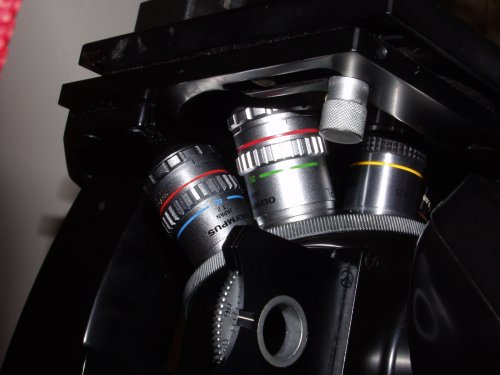
Upgrading a Wild M40
Robert R. Pavlis
Girard, Kansas 66743 USA
The designs of microscopes have changed rather dramatically during the past century. The ones made before World War II are the "classical" microscopes. The best ones were very well constructed because they were hand crafted with "tender loving care." However, their design was rather primitive. The design of microscopes changed dramatically starting about 1950. Many microscopes made in the 1960s and 1970s were still produced in the old tradition of careful craftmanship. Extraordinary care and precision using very high quality materials was the rule of the day. These instruments should easily be in good condition after a century of use! Wild M40 microscopes are certainly in this class.
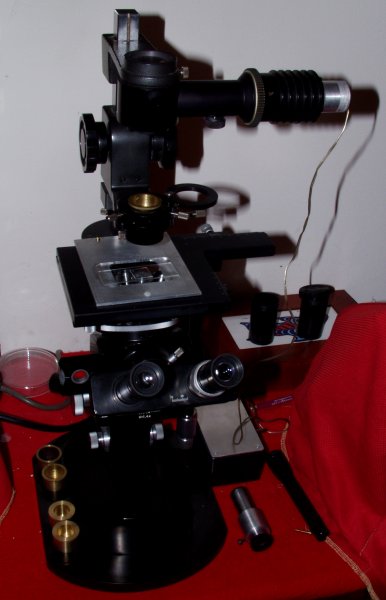 Few—if any—modern microscopes seem to have the quality machining of these older instruments. They had very few plastic parts, often none at all! Pittsburg State University has an Abbe refractometer that was produced in 1897. This ancient instrument is still in working condition, but we removed it from service about four years ago and put it into a display case. The University also has an instrument made in about 1948. This instrument still works very well, and, although it has been mishandled by thousands of students over the past 58 years, it is still in good working order. Pittsburg State University also has another refractometer purchased in 1998. This instrument is now essentially unusable because it has many plastic parts that have already disintegrated. The manufacturer says it cannot repair these instruments because they no longer manufacture spare parts. It is a very sad situation when the 109 year old instrument is still in working order, but the 8 year old one is already at its life's end! Unfortunately other instruments—including many microscopes—seem to follow the same pattern.
Few—if any—modern microscopes seem to have the quality machining of these older instruments. They had very few plastic parts, often none at all! Pittsburg State University has an Abbe refractometer that was produced in 1897. This ancient instrument is still in working condition, but we removed it from service about four years ago and put it into a display case. The University also has an instrument made in about 1948. This instrument still works very well, and, although it has been mishandled by thousands of students over the past 58 years, it is still in good working order. Pittsburg State University also has another refractometer purchased in 1998. This instrument is now essentially unusable because it has many plastic parts that have already disintegrated. The manufacturer says it cannot repair these instruments because they no longer manufacture spare parts. It is a very sad situation when the 109 year old instrument is still in working order, but the 8 year old one is already at its life's end! Unfortunately other instruments—including many microscopes—seem to follow the same pattern.Lenses, especially objectives, follow a very different pattern. The development of powerful computers and new types of glass has resulted in modern objectives being dramatically superior to those produced in the past. Lenses produced by even the best lens makers in 1950 are dreadful when compared to lenses made more recently. The apochromats and fluorites of 1950 had beautiful resolution in their centres, but they had extreme curvature of field. The achromats had flatter fields, but they had poorer resolution.
The dramatic improvement in lens quality seems to have occurred around 1970. Modern lenses are able to achieve flat fields with little chromatic and spherical aberrations. Modern apochromats are corrected for chromatic aberration at four or five wavelengths. The flat field ones provide a flat field across wide field oculars.
Some time ago I obtained a Wild M40 microscope through an eBay auction. It was missing many parts, but was in overall excellent condition. It lacked both a bulb and a power supply. In the February 2006 Micscape, I described how I machined a special holder for the so called "Star LEDs" to provide a superior illumination system for this microscope. When I originally purchased this instrument it was my intention to make it into a really first class instrument. The goal was not to bring it back to its original condition so that it would be museum piece, but rather the goal was to bring it up to modern optical standards.
When I obtained this M40 it had three objectives designed for the 38mm parfocal standard. All were Wild, a 4X, a 10X phase, and a 20X phase for 1.0mm thick glass. Shortly after the era of this instrument most makers started adhering to the DIN standard of 45mm distance between the objective threads and the object plane. The design of the Wild M40 demands that all lenses be near par focal to prevent damaging them by accidently crushing one during focusing! As soon as I had obtained this instrument, I started looking for lenses. After searching the Internet and eBay auctions for nearly a year I was able to obtain the following set:
All six of these lenses require compensating eyepieces. It is extremely inconvenient to have a microscope objective set in which some require these and others do not!

I considered it most important to have good 20X and 40X lenses with spherical correction. The two Olympus lenses are truly excellent.
"Unbranded" Chinese lenses have a very bad reputation. The reality seems to be that purchasing one is rather like going to Monte Carlo or Las Vegas! These lenses vary from extraordinarily good to extraordinarily bad. The ones in the above set are examples of fairly good lenses of this sort. They have quite flat fields, and have good general correction.
Bringing this instrument into working condition required much more than purchasing objectives! Before they could be installed safely there was an extremely important and truly urgent modification that had to be completed!
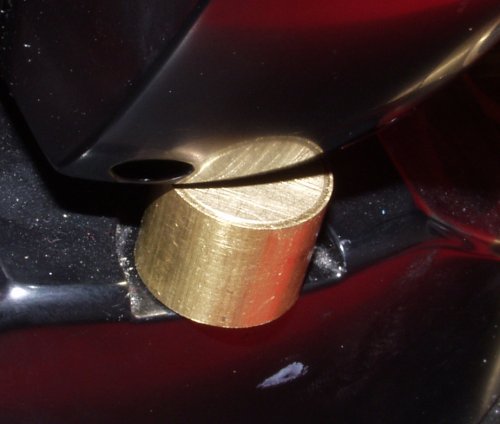
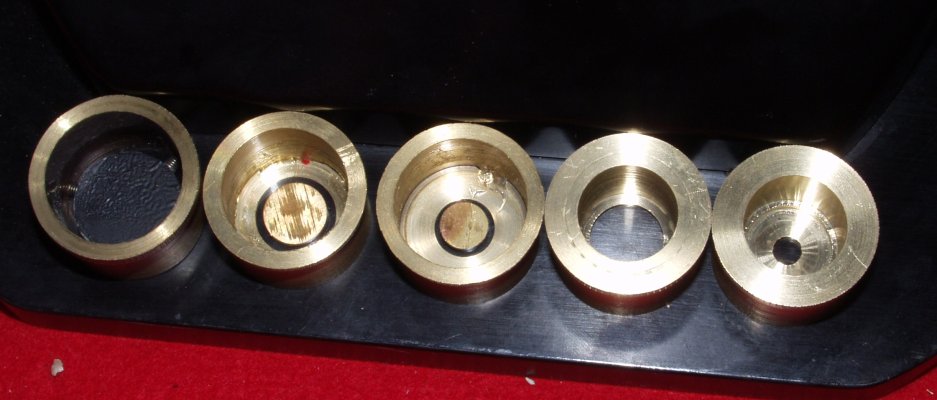
The original instrument was missing the high numerical aperture phase ring, it did have the one that corresponds to the Wild 10X objective. The Wild M40 use a metal cylinders with one end holding a circular glass disk with the phase ring painted on the glass. The paint was peeling from the one that came with the microscope, and it was not the correct size for ANY of the three phase objectives in the new collection. Thus it was time to obtain phase rings. Since no one apparently manufactures these for this microscope there is only one source for them—they have to be machined!
It seemed to me that the microscope manufacturers' system of painting rings on glass was an innately poor design. It really makes more sense to have metal rings. Paint tends to peel from glass after several years. Attaching metal rings with silicone cement should obviously make much more durable rings.
The design of one for the 40X was a bit difficult. The phase ring needs to be so large that there is no easy way to attach a glass mount to hold it. It turned out that schedule 40 "one inch" pipe has the perfect diameter for the outside of a phase ring for the 40X Olympus objective. (Oddly enough, schedule 40 pipe has neither its inner or outside diameter equal to 1.00 inch!) I obtained a piece of brass schedule 40 pipe and used it for this phase ring.
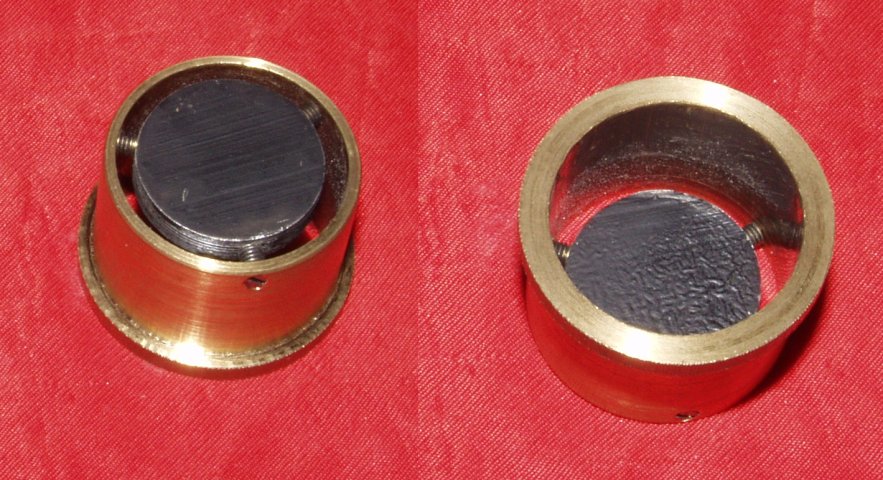
The construction details follow:
Unfortunately the alloy used for brass schedule 40 pipe is difficult to machine. It tends to stick to tools and this results in a very poor finish. I brought the diameter down to 30.1 mm with normal lathe tools and then used a flat file and sandpaper to bring it down the correct diameter.
This phase ring for the 40x objective functioned perfectly after it was finished.
The design of phase ring described above is certainly not appropriate for the much smaller phase rings needed for the 10X and 20X objectives.
The best technique to make these phase rings seemed to be to mount circular glass disks inside turned metal cylinders and then use silicone cement to attach metal disks to the centres of the glass disks. Because machinable brass is so easy to machine it seemed the only sensible choice for this.
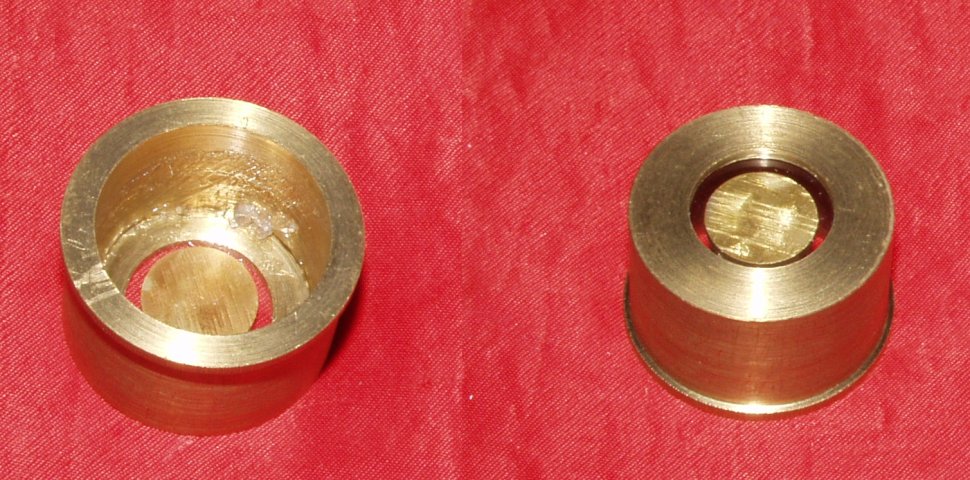
The image below shows one of the phase rings made this way. The best way to make them seems to be the following:
These phase rings also work excellently. The one problem that they have is that cover slips are thin, and these are thus a bit fragile. However, should one break, it would only take a few minutes to repair.
Because phase objectives work best with green illumination I made a second LED holder identical to the one that I described in the February 2006 issue of Micscape, except it has a green LED instead of white. This avoids having to use a green filters. A green LED is much brighter than filtered green light from a white one.
Three of the lenses on the turret are not phase. The condenser does not have an iris. Although it would probably be possible to design some sort of iris system, it seemed simpler to use interchangeable stops. I machined two pieces just like the ones described above, one with a 6mm hole in the centre and the other with a 15mm one to use as stops. The former seems ideal for the 4X lens, the latter for the 10x one. The 25X one works works quite well without any kind of stop in the condenser, but it can also be used with the 15mm diameter stop to provide an image with greater depth of field. Using the 6mm diameter stop with the 40x results in too much loss of resolution, however.
Since the goal has been to keep this instrument in the category of first rate instruments, it needed to have brass body caps. I made a set of these for it using a lathe. Although the instrument originally lacked many important parts, it did have the Wild photo attachment. This was also fitted with a brass body cap!
The original slide holder was not designed for slides and for containers the size of slides. I first machined a little carrier to fit onto the original carrier to hold ordinary slides. Eventually, however, I decided that this was an inferior system, so I machined a complete new carrier for it from aluminium plate. I originally had planned to put clips on it to hold the slides in place, but decided that they really were superfluous.

Actually the special carrier that I made to fit unto the original slide carrier is useful and convenient when using large containers and slides at the same session, otherwise the replacement carrier is far superior.
I also machined a more complex heated stage that uses a small cartridge heater. Using it requires a 10mm objective extension which I obtained from Rolyn optics. I have a LOMO DIN 10X objective that I always use for this purpose because it has a long working distance. Before installing the heated stage I simply remove one of the objectives and install the LOMO 10X objective with the extension. Instead of placing samples on slides, this stage requires placing them between two 18mm cover slips.
Finally there was the matter of oculars. The instrument came without any! For some peculiar reason used oculars sell for rather high prices. Furthermore, such oculars have often been badly damaged from misuse. As mentioned earlier all of the objectives in the torrent require compensating oculars. New Lomo 10x18 compensating oculars sell for less than many used ones! Thus, they were the choice. Their quality is excellent. Although microscope manufacturers have always contended that one must use their brand of compensating oculars with their objectives, generally they are interchangeable.
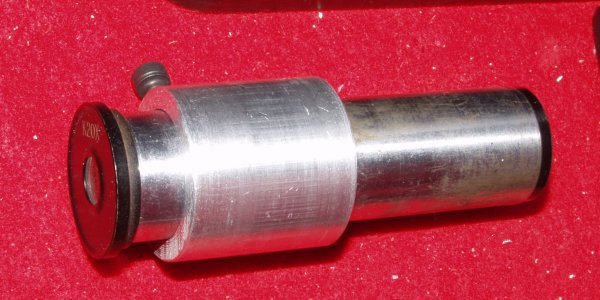
For a phase telescope I machined a collar from aluminium stock and mounted a old 5x ocular without its eye lens on one end, and a 20x one on the other side. I drilled a 3mm hole in a metal disk for a field stop. I basically followed Paul James' design that he described in June 2005 Micscape.
It is a pleasure to use this wonderful microscope now. Because the objectives come from more than one manufacturer they are not perfectly parfocal. That is not really much of an inconvenience, because there is a substantial "setup" when changing objectives anyway. The phase rings need to be changed, and checks need to be made to be certain that the changed one is properly centred and focused. Turning the fine focus knob a bit is really a very minor thing!
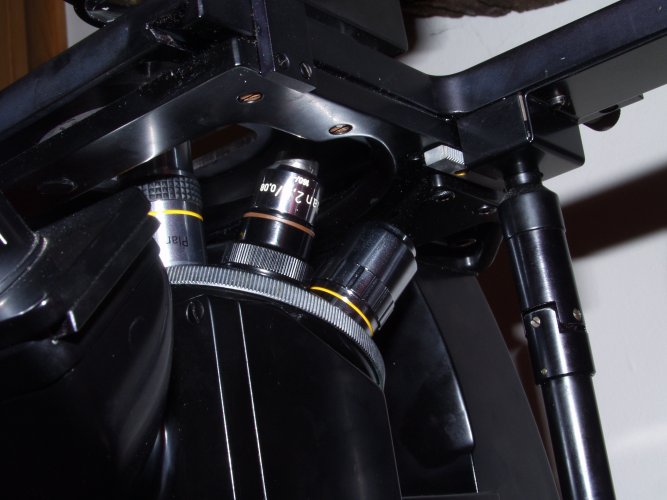
The 2.5X Zeiss flat field objective is very useful. When used with the large phase ring it provides very good dark field illuminated images. When used with the 6mm or 15mm stop it provides excellent bright field images. It is also very useful for locating features to examine at higher power.
The images with all six lenses are quite exceptional. Unlike the original lenses all six give wide flat fields. The wonderful mechanical quality of the old Wild M40 body is now coupled with the superior quality of modern lenses!
I remember using one of these instruments when I was a new faculty member at the University of the Virgin Islands. They were one of the most expensive microscopes available at that time, and they were considered to be at the very top of the line! When it comes to construction quality they still are! The machining and quality construction have resulted in this instrument still retaining a practically perfect mechanical state even though it is now around 40 years old. Back then it really seemed to everyone to be something very special. To me and many other people it still is!
All comments to the author Robert Pavlis are welcomed.
Microscopy UK Front Page
Micscape Magazine
Article
Library
Please report any Web problems or offer general comments to the Micscape Editor .
Micscape is the on-line monthly magazine of the Microscopy UK website at Microscopy-UK